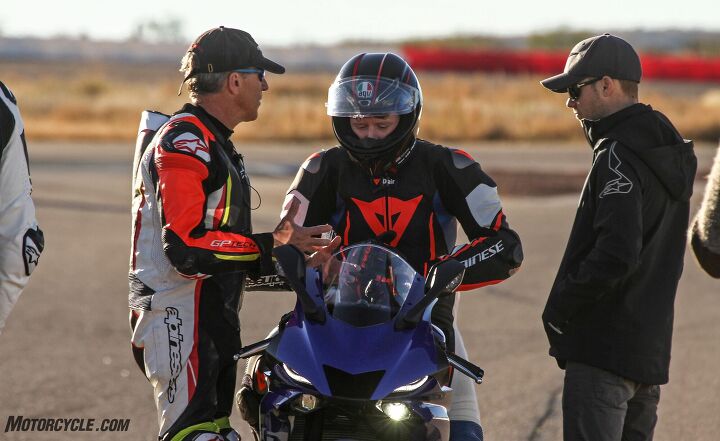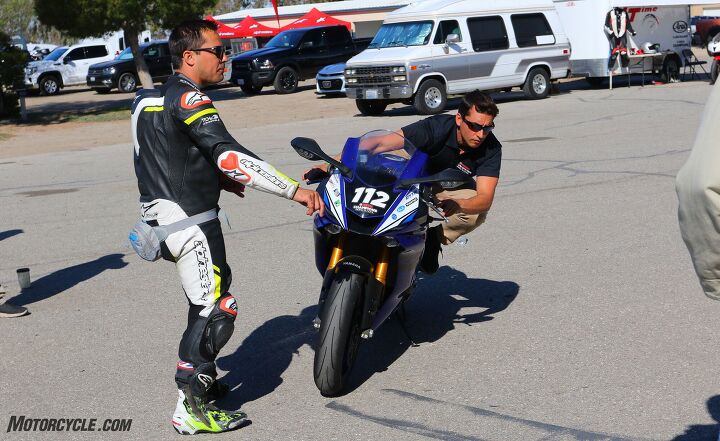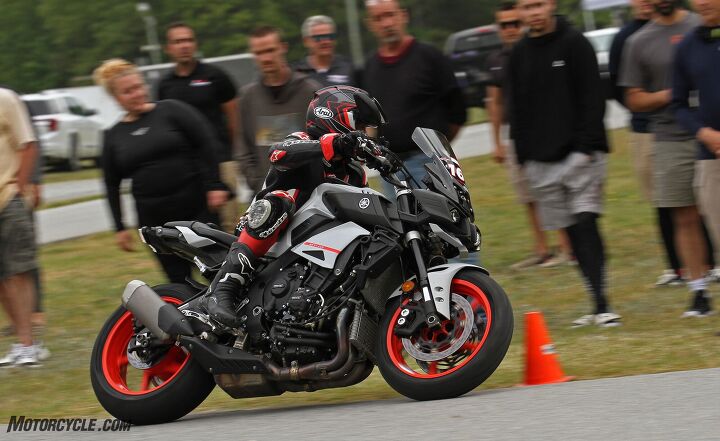Motorsports Racing News & Blog Articles
Old Dog, New Tricks: Going Back To School
I’m a product of rider education. Before I logged my first mile on the street, I spent two weekends on the range, attending an MSF-certified beginning rider’s course in Connecticut. Later, I became a CMSP instructor for the State of California and taught a similar program. Throughout all my years of riding, I’ve attended six different riding schools, some of them multiple times. Additionally, I’ve been fortunate enough to work and ride with some of the most talented motorcyclists around. So, given the folks I ride with, I feel like I am a perpetual student. That’s a good thing. Motorcycling is a sport that offers tremendous rewards to those who pay attention. And you should, because the costs of inattention can be very high.
Off Camber – Old Dog, New Tricks
Yamaha Champions Riding School: ChampSchool
A Different Look At The Yamaha Champions Riding School
While the initial MSF course was instrumental in starting me out on two wheels, I also studied everything I could about motorcycling technique, and perhaps no source had more influence on my survival of those early days, when the learning curve was at its steepest, than Nick Ienatsch‘s 1991 Motorcyclist article, “The Pace.” By taking away the two most common mistakes that cause crashes while sport riding on the street, excessive speed and aggressive, late braking, The Pace allowed riders to calm down and focus on refining their bike-control technique and ability to judge cornering speeds. When Nick moved on from full-time motojournalism, he continued to study (and teach) the art of riding a motorcycle proficiently. He was lead instructor at Freddie Spencer Riding School for 12 years before he became one of the principle forces behind the development and implementation of the Yamaha Champions Riding School. You can read how Nick’s riding philosophy has been refined over time by reading his 2013 “The Pace 2.0” article for Cycle World. (Or better yet, sign up for the excellent online Champ U course for a deep dive into the current curriculum utilized in the YCRS program.) The YCRS program represents the current state-of-the-art in Nick’s journey as a champion of riding skills instruction.
The attitude of being a student of the sport is something that doesn’t get enough discussion. The desire to learn is what separates the truly great riders from the merely talented ones. We can see this on the track as racers continually reach to find the limits that their motorcycle and conditions allow, since they change from day to day or even hour to hour. Then there are the larger changes that are made from season to season as technology requires (or enables) a change in technique. Valentino Rossi successfully extended his career (and championship count) by completely revamping his riding style from the more upright and centered riding position of his forebears to the inside and elbow-dragging forward position seen in his technique from 2014 onward. For those of us who ride on the street, this same technique of approaching every ride as an opportunity to learn is also applicable – no, essential – to mastering the art of riding a motorcycle.
With this background in Nick’s approach to teaching riding and after reading both Ryan’s article about attending YCRS and Troy’s about being an instructor for the school, I knew that this curriculum would be perfect for fixing some of my bad habits and polishing up my riding technique.
Weak Spots
As said in my lead-in article to this series, some areas of my riding technique had bothered me for a while. The biggest issue I had was that I was riding more and more completely in the saddle and not cheating my weight to the inside – even on the track. By staying centered, I was doing two things. First, it required that I lean the motorcycle over more for any given cornering speed, and if you read The Pace 2.0, you know that lean equals risk. While I still want to experience the pleasures of track riding, my aversion to falling down has increased as I have aged. I knew that adjusting my body position would allow me to carry less lean at any given speed. I just hadn’t been successful in ameliorating the issue on my own. The second benefit of changing my body position is that it would allow me to corner faster, and the thrill of motorcycling has always been about leaning my way through corners.
In addition to my body position issues, I’d noticed some increasing cautiousness on the brakes that I felt was holding me back. I’d had better luck with working on my braking technique by myself, but I felt that another’s watchful eyes and tips might really take out some of the slop I was feeling on the brakes.
Finally, I’d noticed on the track that I was spending less time at full throttle on the straights. Where’s the fun in that? I assumed that once I cleaned up the other areas of my technique, the speed would return.
The Thoughtful Rider
Since Ryan and Troy have so thoroughly covered what goes on in a YCRS class, for this article, I’m going to focus more on why I think YCRS works so well. I believe that four things are behind the reason why spending two days at YCRS has had a profound effect on my riding.
First, the extensive Champ U curriculum is included with YCRS. Since it is sold as a separate class you can take without the associated track component, making it perfect for off-season study, you shouldn’t be surprised to open the website to find a wide swath of material to cover. This isn’t something you pop open the night before you attend the class. Rather, you have to invest some time studying it.
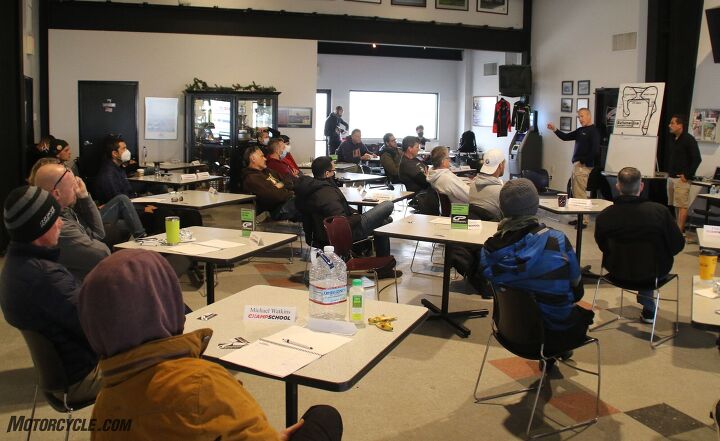
If you want to get the most out of your time at YCRS, be sure to complete the Champ U curriculum to get up to speed on all the concepts covered.
The 12 sections of the riding theory behind Champ U are broken up into three or more topics with a video and quiz attached. The quizzes make sure that you take away the key points from each module, giving you immediate feedback if you submit a wrong answer. While the videos cover a bunch of information, they are fun, too. The beauty of this approach to the topics is that it makes sure that all students (provided they did the work) arrive at the school with the same base knowledge and language, which means that less time is spent getting students up to speed and more time can be spent immersing the class in the topics or practicing them on the track.
Second, the structure of the classroom sessions is set up differently than most schools. Instead of having one expert (usually, name-brand) rider standing in front of the students passing on pearls of wisdom, YCRS, while still utilizing a lead instructor, also gives the other instructors an active role within the classroom sessions. They are typically standing beside the lead and volunteer or are prompted to give examples of the concept being discussed. Since everyone learns in different ways, this discussion format has a higher chance of reaching all the students. Additionally, the informality tacitly gives students permission to ask questions more frequently.
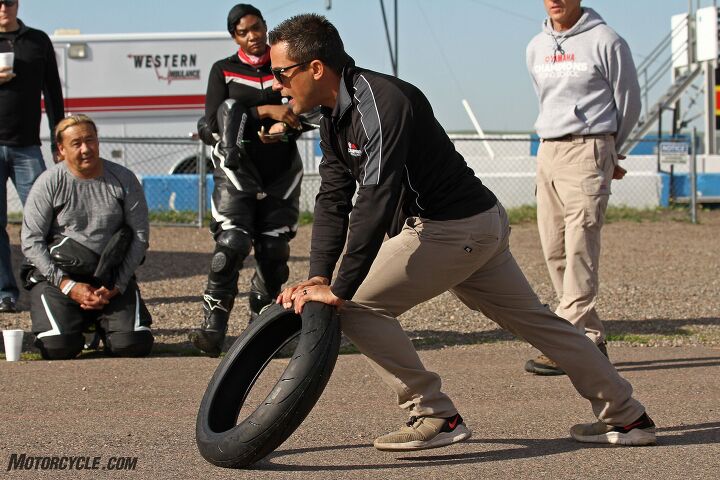
The 100 Points of Grip is one of the foundational concepts of YCRS. Put it into your daily riding practice, and you’ll reap the benefits on both the street and track.
Finally, every track session has a specific skill for the students to focus on. While this may not be unique to YCRS, the session is usually accompanied by a mantra to associate with the skill. Sayings like, “load the tire before you work the tire” and “lighter longer,” make it possible for the student to keep the essential technique in the forefront of their mind even with all the other distractions the track environment offers. This use of language illustrates the level of refinement that has gone into the coursework over the years of development that Nick and his teammates have put into the program. And the mantras work. A couple of months after attending the class, they still pop into my head at the appropriate time on all manner of street and track rides.
The on-track exercises exhibit the same level of refinement, with each new exercise building on the skills practiced earlier in the day. These exercises culminate in my favorite exercise, The Pointy End of the Cone, which tasks the students with adjusting their line in a corner to only pass cones, which are set at various places on the track, at their pointy end. The kicker is that the instructors move the cones from lap-to-lap, meaning that the students don’t know what their line through the corner will be until they are approaching it. Through cone placement, the instructors force the students to adapt to a wide variety of conditions in a corner, from a wide super-late apex to a tight early apex to a mid-corner change of line. To succeed, the rider must keep their eyes up to see the next cone, utilize the proper braking technique to help adjust the bike’s speed and line through the corner, apply throttle smoothly, and have the correct body position.
This game has a direct application to the most risky form of motorcycling, street riding, and represents many of the ways in which a street rider might encounter obstacles out on a winding road. If you blow it, you’re just going to pass a cone on the track and take the experience on to the next corner. On the street, the consequences are much higher. Becoming a better, safer rider is the point of YCRS. (Don’t worry, go-fast folks, speed is a natural side-effect of increased competence. And riders more interested in street skills and less about speed, the school is divided into two groups, slow and fast, to address the needs of both better.)
Finally, the excellent staff that support the students out on the track play a vital role in passing on the curriculum. With a student to staff ratio of 8:1, there are numerous opportunities out on the track to get pointers from the instructors. Several times, instructors passed me and gestured for me to follow while they modeled the current skill. Other times, they pulled me into the pits for a quick conversation. By building a relationship with the instructors, students feel freer to ask for individual help. Before a couple of track sessions, I asked an instructor for advice, and they spent the first few laps leading and following me before moving on to assist other students. This type of coaching is priceless.
After School Lessons
As I said before, a few months – and a couple of track days – have passed since I attended YCRS. Of all the schools I have attended (most of which were quite good and helped me with my technique), YCRS has had the most dramatic and immediate effect on my riding. On the street, I feel more connected with my bike, and at the track, my speed and confidence have improved considerably. I attribute this to not just to the wide swath of instruction I was given, though it was instrumental in the change. Rather, a simple technique given in YCRS continues to keep the program fresh in my mind. This is in the statement that my class was instructed to write on the cover of our class manual: “Before I ride, I have a plan.” On every ride, to get myself in the proper frame of mind, I take a moment before I click the bike in gear and focus on what I will be concentrating on for that ride. The goals vary with the environment and the purpose of the ride, but the mental readiness it prompts is what I’m looking for.
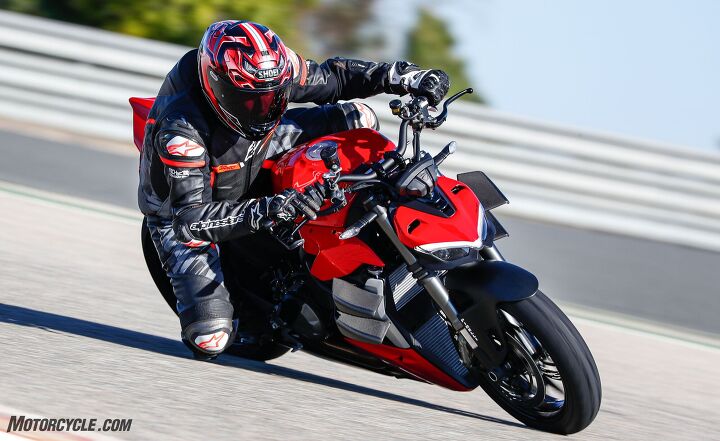
Just days after attending YCRS, I was back on the track utilizing the techniques and feeling much more comfortable at speed.
For 2022, Yamaha Champions Riding School offers 25 different opportunities for riders of all skill levels to attend one of its courses nationwide. And I do mean all skill levels. At my class there were students who had only been riding for a few days just soaking up the information. Similarly, all types of bikes are covered from Harley-only courses to racer-specific ones. Classes range from single- to multi-day schedules, and private instruction is available. Go to the YCRS website to learn more.
Become a Motorcycle.com insider. Get the latest motorcycle news first by subscribing to our newsletter here.
The post Old Dog, New Tricks: Going Back To School appeared first on Motorcycle.com.
Copyright
© Motorcycle.com


